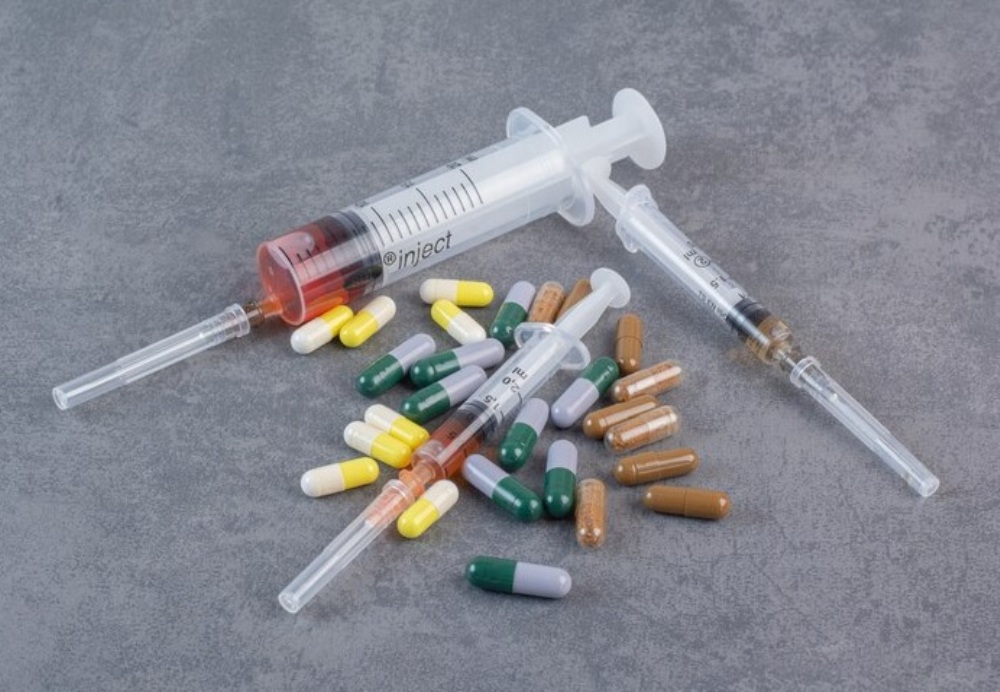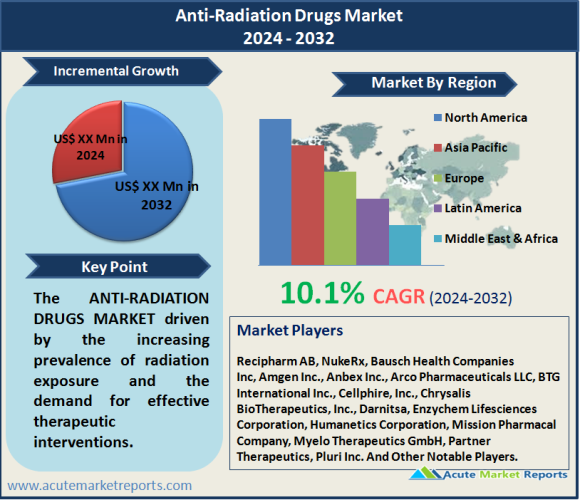
The anti-radiation drugs market is expected to grow at a CAGR of 10.1% during the forecast period of 2025 to 2033, driven by the increasing prevalence of radiation exposure and the demand for effective therapeutic interventions. While distribution challenges present a notable constraint, the market's dynamic nature is evident in the distinct roles of compounds and applications. As North America leads in revenue and Asia-Pacific emerges as a growth hub, strategic initiatives by key players underscore the collaborative efforts shaping the market's trajectory. The imperative for overcoming distribution challenges and advancing therapeutic applications positions the anti-radiation drugs market on a path of continuous evolution and innovation.
Key Market Drivers
Potassium Iodide (KI) Driving Market Growth
Potassium Iodide (KI) stands as a pivotal driver in the anti-radiation drugs market. With its well-established role in thyroid protection during radiation emergencies, KI has witnessed increased adoption worldwide. Evidence supporting this driver includes the widespread distribution of KI tablets by government agencies for public use in the event of nuclear accidents. For instance, the U.S. Nuclear Regulatory Commission recommends the use of KI as a thyroid-blocking agent during radiological emergencies, underscoring its significance in radiation protection.
Expanding Applications in Cancer Treatment
The expanding applications of anti-radiation drugs in cancer treatment contribute significantly to market growth. Prussian Blue, known for its efficacy in treating internal contamination with radioactive cesium and thallium, exemplifies this driver. The evidence lies in the clinical use of Prussian Blue to enhance the elimination of radioactive isotopes in patients, minimizing radiation exposure and improving therapeutic outcomes. The adoption of anti-radiation drugs as adjuncts to cancer therapy reflects their evolving role beyond emergency situations.

Increasing Preparedness for Nuclear Events
The global increase in preparedness for nuclear events acts as a key driver for the anti-radiation drugs market. Diethylenetriamine Pentaacetate (DTPA) and other chelating agents play a crucial role in treating individuals exposed to radioactive materials. The evidence supporting this driver includes the inclusion of DTPA in emergency response plans and medical countermeasures to address radiological incidents. Governments and healthcare institutions worldwide are actively enhancing their capabilities to respond to nuclear emergencies, fostering the demand for anti-radiation drugs.
Restraint
Challenges in Distribution Channels
A significant restraint in the anti-radiation drugs market is associated with challenges in distribution channels. Despite the critical nature of these drugs, their availability in various distribution channels poses logistical challenges. Evidence supporting this constraint includes the limited accessibility of anti-radiation drugs in retail pharmacies and other outlets, hindering swift access for individuals in need. Overcoming these distribution challenges is crucial to ensuring timely and widespread availability during radiation emergencies.
Market Segmentation Analysis
Market by Compound: Potassium Iodide (KI) Dominates the Market
In 2024, Potassium Iodide (KI) emerged as the revenue leader, driven by its widespread use in radiation emergencies. Simultaneously, DTPA exhibited the highest CAGR, underscoring its increasing adoption for treating individuals exposed to radioactive materials. The evidence lies in the distinct roles these compounds play – KI for thyroid protection and DTPA for chelation therapy, demonstrating the market's dynamic nature and diverse applications.
Market by Application: ARS Dominates the Market
The market segmentation by application showcased ARS as the revenue leader in 2024, emphasizing the crucial role of anti-radiation drugs in addressing acute radiation effects. However, the Cancer Treatment segment exhibited the highest CAGR, indicating the growing utilization of these drugs in therapeutic settings. The evidence supporting this lies in clinical studies and advancements in cancer treatment protocols that incorporate anti-radiation drugs.
Market by Distribution Channel: Hospital Pharmacies Dominate the Market
Hospital Pharmacies led in both revenue and CAGR in 2024, emphasizing the pivotal role of healthcare institutions in dispensing anti-radiation drugs. The evidence lies in the specialized nature of these drugs, requiring expert guidance and oversight. Retail Pharmacies, while contributing to accessibility, exhibited a lower CAGR, reflecting the challenges in distributing specialized medications through traditional retail channels.
North America Remains the Global Leader
North America emerged as the region with the highest revenue and CAGR in 2024, driven by robust preparedness initiatives and a well-established regulatory framework. The evidence supporting this includes government programs for distributing KI tablets and enhancing medical countermeasures. Asia-Pacific showcased substantial growth potential, with a focus on improving nuclear emergency response capabilities and increasing awareness of anti-radiation drugs.
Market Competition to Intensify during the Forecast Period
In 2024, top players such as Recipharm AB, NukeRx, Bausch Health Companies Inc, Amgen Inc., Anbex Inc., Arco Pharmaceuticals LLC, BTG International Inc., Cellphire, Inc., Chrysalis BioTherapeutics, Inc., Darnitsa, Enzychem Lifesciences Corporation, Humanetics Corporation, Mission Pharmacal Company, Myelo Therapeutics GmbH, Partner Therapeutics, and Pluri Inc. played pivotal roles in the anti-radiation drugs market. Their key strategies encompassed partnerships, regulatory approvals, and advancements in drug formulations. Recipharm's collaboration with Cumberland Pharmaceuticals for the manufacturing and commercialization of Ethyol reflects the strategic alliances shaping the market. NukeRx's focus on developing innovative radiation countermeasures and Bausch Health's commitment to expanding their radiation-related product portfolio contribute to the competitive dynamics.
Historical & Forecast Period
This study report represents analysis of each segment from 2023 to 2033 considering 2024 as the base year. Compounded Annual Growth Rate (CAGR) for each of the respective segments estimated for the forecast period of 2025 to 2033.
The current report comprises of quantitative market estimations for each micro market for every geographical region and qualitative market analysis such as micro and macro environment analysis, market trends, competitive intelligence, segment analysis, porters five force model, top winning strategies, top investment markets, emerging trends and technological analysis, case studies, strategic conclusions and recommendations and other key market insights.
Research Methodology
The complete research study was conducted in three phases, namely: secondary research, primary research, and expert panel review. key data point that enables the estimation of Anti-Radiation Drugs market are as follows:
Market forecast was performed through proprietary software that analyzes various qualitative and quantitative factors. Growth rate and CAGR were estimated through intensive secondary and primary research. Data triangulation across various data points provides accuracy across various analyzed market segments in the report. Application of both top down and bottom-up approach for validation of market estimation assures logical, methodical and mathematical consistency of the quantitative data.
| ATTRIBUTE | DETAILS |
|---|---|
| Research Period | 2023-2033 |
| Base Year | 2024 |
| Forecast Period | 2025-2033 |
| Historical Year | 2023 |
| Unit | USD Million |
| Segmentation | |
Compound
| |
Application
| |
Distribution Channel
| |
|
Region Segment (2023-2033; US$ Million)
|
Key questions answered in this report